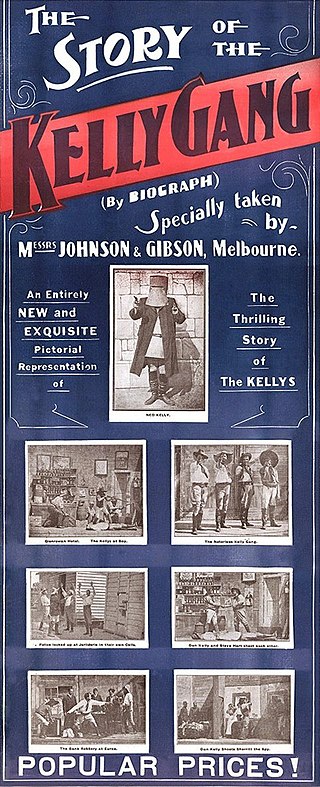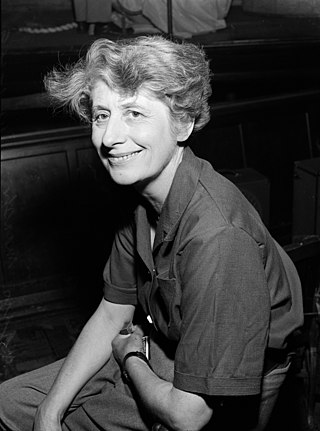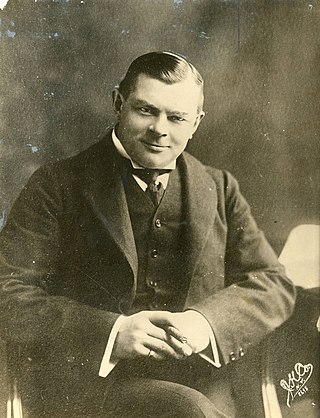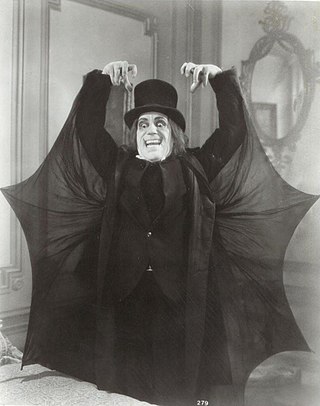Related Research Articles

Thunderbolt is a 1910 Australian feature film based on the life of the bushranger Captain Thunderbolt. It was the directorial debut of John Gavin who later claimed it was the first "four-reel movie" made in Australia. It has also been called the first film made in New South Wales.

The Story of the Kelly Gang is a 1906 Australian Bushranger film directed by Charles Tait. It traces the exploits of 19th-century bushranger and outlaw Ned Kelly and his gang, with the film being shot in and around Melbourne. The original cut of this silent film ran for more than an hour with a reel length of about 1,200 metres (4,000 ft), making it the longest narrative film yet seen in the world. It premiered at Melbourne's Athenaeum Hall on 26 December 1906 and was first shown in the United Kingdom in January 1908. A commercial and critical success, it is regarded as the origin point of the bushranging drama, a genre that dominated the early years of Australian film production. Since its release, many other films have been made about the Kelly legend.

Dame Edith Ngaio Marsh was a New Zealand mystery writer and theatre director. She was appointed a Dame Commander of the Order of the British Empire in 1966.
A feature film or feature-length film, also called a theatrical film, is a narrative film with a running time long enough to be considered the principal or sole presentation in a commercial entertainment program. The term feature film originally referred to the main, full-length film in a cinema program that included a short film and often a newsreel. Matinee programs, especially in the US and Canada, in general, also included cartoons, at least one weekly serial and, typically, a second feature-length film on weekends.
Movietone News was a newsreel that ran from 1928 to 1963 in the United States. Under the name British Movietone News, it also ran in the United Kingdom from 1929 to 1986, in France also produced by Fox-Europa, in Spain in the early 1930s as Noticiario Fox Movietone before being replaced by No-Do, in Australia and New Zealand until 1970, and Germany as Fox Tönende Wochenschau. An Indian version called Indian Movietone News ran in 1942 and 1943 before getting replaced by Indian News Parade.

Charles Urban was a German-American film producer and distributor, and one of the most significant figures in British cinema before the First World War. He was a pioneer of the documentary, educational, propaganda and scientific film, as well as being the producer of the world's first successful motion picture colour system.
The Limelight Department was one of the world's first film studios, beginning in 1898, operated by The Salvation Army in Melbourne, Australia. The Limelight Department produced evangelistic material for use by the Salvation Army, including lantern slides as early as 1891, as well as private and government contracts. In its 19 years of operation, the Limelight Department produced about 300 films of various lengths, making it one of largest film producers of its time.

A lost film is a feature or short film in which the original negative or copies are not known to exist in any studio archive, private collection, or public archive. Films can be wholly or partially lost for a number of reasons. Early films were not thought to have value beyond their theatrical run, so many were discarded afterward. Nitrate film used in early pictures was highly flammable and susceptible to degradation. The Library of Congress began acquiring copies of American films in 1909, but not all were kept. Due to improvements in film technology and recordkeeping, few films produced in the 1950s or beyond have been lost.

The Kelly Gang is an Australian feature-length film about the Australian bush ranger, Ned Kelly. The film was released in 1920, and is the second film to be based on the life of Ned Kelly, the first being The Story of the Kelly Gang, released in 1906.
Charles Tait was an Australian concert, film and theatrical entrepreneur. His most notable achievement was as the director and writer of The Story of the Kelly Gang regarded as the world's first feature-length film. The film was first shown on 26 December 1906.

In the Wake of the Bounty (1933) is an Australian film directed by Charles Chauvel about the 1789 Mutiny on the Bounty. It is notable as the screen debut of Errol Flynn, playing Fletcher Christian. The film preceded MGM's more famous Mutiny on the Bounty, starring Charles Laughton and Clark Gable, by two years.

Andrew George Scott, also known as Captain Moonlite, though also referred to as Alexander Charles Scott and Captain Moonlight, was an Irish-born New Zealand immigrant to the Colony of Victoria, a bushranger there and in the Colony of New South Wales, and an eventual and current day Australian folk figure.

The National Film and Sound Archive of Australia (NFSA), known as ScreenSound Australia from 1999 to 2004, is Australia's audiovisual archive, responsible for developing, preserving, maintaining, promoting, and providing access to a national collection of film, television, sound, radio, video games, new media, and related documents and artefacts. The collection ranges from works created in the late nineteenth century when the recorded sound and film industries were in their infancy, to those made in the present day.
Film Australia was a company established by the Government of Australia to produce films about Australia in 1973. Its predecessors were the Cinema and Photographic Branch (1913–38), the Australian National Film Board, and the Commonwealth Film Unit (1956–72). Film Australia became Film Australia Limited in 1988 and was consolidated into Screen Australia in 2008.

Dancing with Crime is a 1947 British film noir film directed by John Paddy Carstairs, starring Richard Attenborough, Barry K. Barnes and Sheila Sim. A man hunts down the killer of his lifelong friend.
The Bells is a 1911 Australian feature-length silent film directed by W. J. Lincoln. It is based on the famous stage melodrama by Erckmann-Chatrian, adapted by Leopold Lewis, which in turn had been adapted for the Australian stage by W. J. Lincoln before he made it into a film.

William Alfred Gibson was an Australian film producer and exhibitor best known for his collaboration with Millard Johnson. He was one of the producers of The Story of the Kelly Gang (1906) and helped establish Amalgamated Pictures.

The Gaiety Theatre and Grand Hotel is a historic theatre and hotel in Zeehan, Tasmania, Australia.
References
- 1 2 "Caring for the Corrick Collection". National Film and Sound Archive.
- ↑ "LIFE & LETTERS". The West Australian . Perth. 4 May 1946. p. 5. Retrieved 30 June 2015– via National Library of Australia.
- ↑ ""Kelly Gang" Film Began Era Of "Feature" Pictures". The Sunday Herald . Sydney. 9 October 1949. p. 9 Supplement: Features. Retrieved 30 June 2015– via National Library of Australia.
- ↑ "Lost film footage of Edwardian London discovered". The Daily Telegraph . 23 October 2008.
- ↑ "Charles Urban: Films Online". charlesurban.com. Retrieved 13 July 2015.
- ↑ Ngaio Marsh: A Life by Margaret Lewis (1991) pp.38